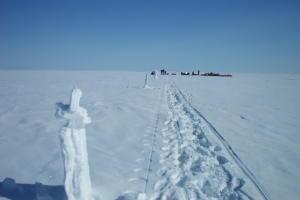4 April, 2002
Snowboard case, camera tripod and fiber
optics!!!! It sounds like a setup for the X-games
on ESPN. However, it's science…..in the cold…
Wrapped inside a blanket tucked in a snowboard
bag lies the camera tripod. The snowboard bag
also holds the fiber optic cable holder. The
camera tripod is set up on the snowpack and
checked to see if it is level. The metal bar
that sets tightly on top the tripod is precisely
placed and now we are ready for the delicate
material…. The fiber optics.
The black fiber-optic cable and metric probe are
carefully stored in a wooden box packed with
foam. It is gently taken out of the box and the
cable is unwrapped with care. The fiber-optic
cable can be easily broken, so it is important to
be careful. The black fiber-optic cable travels
down the metric probe and is attached to a sensor
at the bottom of the probe. The end of the fiber-
optic cable is then attached to fiber-optic
converter box that attaches to the computer
inside the heated sled.
Are you confused yet? Are you wondering what we
are doing? What is all of this technical setup
for? It's not the x-games or a photo shoot. This
measurement is called the light attenuation
probe, which measures the amount of light that
penetrates into the snowpack. There are more fine
details on the operation of the light attenuation
probe.
One person sits outside in the cold and, using the
tripod, lowers the sensor into the snow. It is
important to have the tripod and entire setup
level. This person is talking to the WIZARD
inside the heated sled. I always feel like I am
talking to the Wizard of Oz - the wizard who sets
behind the curtain controlling the world outside.
Our wizard sits in the heated sled running the
computer program that computes the light
attenuation. The cold person outside lowers the
probe down, centimeter by centimeter into the
snowpack. After a new depth is reached, the
wizard hits some buttons on the computer and the
data are recorded. The sensor at the end of the
metric probe measures the amount of light and
sends the signal up the fiber optic cable and
transmits the light intensity into the computer.
The wizard and the cold person…… The wizard
computes in the heated sled while the cold person
fumbles with mittens and bundles of clothes
handling the delicate instrument. Science
measurements are collected and stored!
More light lessons later!!!
SO WHERE IS MRS. CHEUVRONT????? LET'S PLOT!!!
Latitude: 66.70197 degrees North
Longitude: 160.01095 degrees West
Our departure from Selawik brought us outside to
the sunny, snow, cold, world. It felt good to be
out on the trail once again…. On the move. The
trail was good for traveling and the base of the
Brooks Range stayed on the horizon. It was out
there… the fabulous Brooks Range… our soon to be
future. Three sites were completed today. The
sun energized our work. We traveled on heading
north on the trail to Ambler. We traveled mostly
on open tundra and shrub areas. The deeper snow
gives us clues of our farther travels north.
After departing from the open land, trees were
spotted for the first time in many days. Spruce
trees and even some Birch trees were standing
along a riverbank. A large moose with her calf
stood along the riverbank grazing amongst the
bushes. The moose and her young had greeted us
to our home for the evening. A shelter cabin
along the trail to Ambler would be our home. A
simple cabin, but warm and cozy details our
evening.
Temperature Max: -6 degrees Celsius
Temperature Min: -15 degrees Celsius

Running the Light Attenuation Probe.

Looking down the 100 meter line. This is how the snow looks after we finish our measurements. The snow scuptures are from digging the snow pits!
Contact the TEA in the field at
.
If you cannot connect through your browser, copy the
TEA's e-mail address in the "To:" line of
your favorite e-mail package.
|
